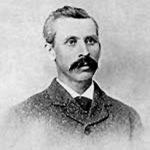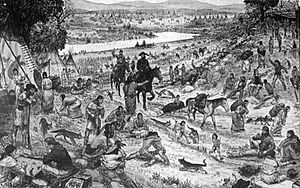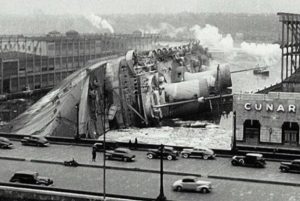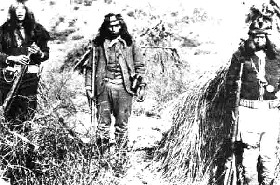Reminiscing
 Shortly after President Thomas Jefferson completed the Louisiana Purchase from France, which made it an American territory, William Ashley, who was a Virginia native, made the decision to move to Missouri. Ashley was a young man, who was looking to make a name for himself. He entered into a partnership with Andrew Henry to manufacture gunpowder and lead. Opportunists, Ashley and Henry took advantage of the fact that these two commodities were in short supply in young America.
Shortly after President Thomas Jefferson completed the Louisiana Purchase from France, which made it an American territory, William Ashley, who was a Virginia native, made the decision to move to Missouri. Ashley was a young man, who was looking to make a name for himself. He entered into a partnership with Andrew Henry to manufacture gunpowder and lead. Opportunists, Ashley and Henry took advantage of the fact that these two commodities were in short supply in young America.
Ashley’s business prospered during the War of 1812, and he also joined the Missouri militia. He eventually achieved the rank of general. When Missouri became a state in 1822, Ashley used his military fame, and his business success to win election at lieutenant governor. Once elected, Ashley set about looking for opportunities to enrich both Missouri and his own pocketbook. Because he knew the area, he realized that Saint Louis was in a perfect place to exploit the fur trade on the upper Missouri River.
Ashley recruited his old business partner, Henry to join him in this new venture. Then, Ashley placed an advertisement in the Missouri Gazette and Public Advisor seeking 100 “enterprising young men” to engage in fur trading on the Upper Missouri. The advertisement was a big success. Scores of young men responded and came to Saint Louis. Among them were such future legendary mountain men as Jedediah Smith and Jim Bridger, as well as the famous river man Mike Fink. In time, these men and dozens of others would go on to uncover many of the geographic mysteries of the Far West, but for now they were looking to make a living trapping animals for their furs.
1822 found Ashley and a small band of his fur trappers building a trading post on the Yellowstone River in Montana in order to expand outward from the Missouri River. The Arikara Indians didn’t like this invasion, and they were deeply hostile to Ashley’s attempts to undercut their long-standing position as middlemen in the fur trade. The ensuing attacks eventually forced the men to abandon the Yellowstone post. Out of desperation, Ashley hit on a new strategy. Instead of building central permanent forts along the major rivers, he decided to send his trappers overland in small groups traveling by horseback. By avoiding the river arteries, the trappers could both escape detection by hostile Indians and develop new and untapped fur regions. Almost by accident, Ashley invented the famous “rendezvous” system that revolutionized the American fur trade. The necessary supplies were delivered and furs were delivered at meetings in a large meadow near the Henry’s Fork of Wyoming’s Green River in the early summer of 1825.
Ashley’s first fur trapper rendezvous was very successful. Ashley took home a tidy profit for his efforts. The fur  trappers not only had an opportunity to trade for supplies, but a chance to enjoy a few weeks of often drunken socializing. Ashley organized a second highly profitable rendezvous in 1826, and then decided to sell out. While he was no longer a part of it, his rendezvous system continued to be used by others. The system eventually became the foundation for the powerful Rocky Mountain Fur Company. With plenty of money in the bank, Ashley was able to return to his first love…politics. He was elected to Congress three times and once to the Senate, where he helped further the interests of the western land that had made him rich.
trappers not only had an opportunity to trade for supplies, but a chance to enjoy a few weeks of often drunken socializing. Ashley organized a second highly profitable rendezvous in 1826, and then decided to sell out. While he was no longer a part of it, his rendezvous system continued to be used by others. The system eventually became the foundation for the powerful Rocky Mountain Fur Company. With plenty of money in the bank, Ashley was able to return to his first love…politics. He was elected to Congress three times and once to the Senate, where he helped further the interests of the western land that had made him rich.

 Most kids have, at one point or another, imagined that they were hunting for lost treasure. Some people, however, continue to be treasure hunters well into adulthood. Such was the case with two Michigan-based treasure hunters in 2011. The men were hunting for gold in Lake Michigan. Of course, that doesn’t mean they were looking for gold nuggets, like the gold rush days of old. They were looking for gold in the many shipwrecks of the Great Lakes.
Most kids have, at one point or another, imagined that they were hunting for lost treasure. Some people, however, continue to be treasure hunters well into adulthood. Such was the case with two Michigan-based treasure hunters in 2011. The men were hunting for gold in Lake Michigan. Of course, that doesn’t mean they were looking for gold nuggets, like the gold rush days of old. They were looking for gold in the many shipwrecks of the Great Lakes.
On this particular treasure hunting expedition, Kevin Dykstra and Frederick Monroe were searching for $2 million in gold that had, according to local legend, fallen from a ferry crossing Lake Michigan in the 1800s. While moving their sonar over the lake, it caught a mass below. Dykstra dove into the water to video the mass. “I didn’t go down there with the expectation of seeing a shipwreck–I can tell you that,” Dykstra told Live Science. Nevertheless, there beneath the cold waves of Lake Michigan was an aging shipwreck. Brown and gray zebra mussels, encrusted the wooden planks of the old ship. When Dykstra and Monroe reviewed the video, they realized that the ship might be the remnants of a 17th-century ship called the Griffin, or Le Griffon. French explorer René-Robert Cavelier, Sieur de La Salle built the ship in 1679. It was lost in Lake Michigan the same year.
Some experts were not convinced that the men had indeed found the Griffin. The experts thought it might be the remnants of a tugboat that was scrapped after “steam engines became more economical to operate,” said Brendon Baillod, a Great Lakes historian, who has written scholarly papers on the Griffin. More evidence was needed to prove that this ship was the Griffin. State archaeologists reviewed the footage, and “They’ve been very diligent to say, ‘This is really interesting; these are some neat pictures,'” Dykstra said. “Can we call this the Griffin? Certainly not–not without a lot more information–but these are very compelling.”
La Salle apparently sailed the Griffin through the Great Lakes and crossed into Lake Michigan in an effort to reach the mouth of the Mississippi River, according to Baillod. Running out of money, he disembarked with the other expedition leaders, leaving the ship and its crew to pay off his debts with furs. “La Salle never saw the Griffin again. La Salle returned to the area in 1682, to try again to locate the Mississippi’s mouth. But members of the Potawatomi tribe brought pieces of the ship to the explorer, including some moldy beaver furs and a pair of sailor’s britches,” said Baillod, who translated La Salle’s journal from French to English.
The Native Americans told La Salle that the crew planned to sail toward the Straits of Mackinac in stormy weather. “The [American] Indians told the captain not to sail out, to wait the storm out, but he wouldn’t listen to them,” Baillod said. Of course, because of his haste to set sail, the captain lost control of the ship in the strong winds. The ship was blown away from shore, southward, toward some islands in the distance. “They lost the ship from sight,” Baillod said, “and that’s the last anybody has ever seen the Griffin.”
About 30 various adventurers have claimed to have found the Griffin, but have never really been able to prove their claim. “They’re looking for something else, they find an old ship and they’ve heard of the Griffin, so they pronounce it the Griffin,” Baillod said. According to Baillod, none of these adventurers were looking near the Beaver Island area, which was most likely the area the ship went down. But the latest finding, made popular again by Wreck Diving Magazine in its latest issue, holds a number of clues about the ship’s past. “There was no rudder on the boat,” Dykstra said. “That was kind of telling to us that the ship probably weathered a storm; otherwise, there would probably be a rudder on it.” They also found a part of the ship that they said could be a mussel-covered griffin, the mythical beast carved onto the ship’s bow.
Dykstra was so intrigued that he went back to have another look. He took a magnet with him to help determine the metal composition of the ship. Purely by accident, a nail attached itself to the magnet. The treasure hunters discovered it later, once they were above water. “When we had it looked at, they [the archaeologists] could tell that the nail was very old,” Dykstra said. “It was a hand-forged nail, which helps date it back to that time period, we feel.” Of course, this accident could have landed the men in hot water with the state of Michigan, which has rules stipulating that artifacts found on state land, including the land at the bottom of the Great Lakes, are state property. “The two men did not bring up the nail on purpose, and they plan to return it to the state,” said Dean Anderson, the state archaeologist for Michigan.
About 1,500 shipwrecks have been found on the bottom of Lake Michigan, Anderson said, and it’s unclear whether this one is the Griffin. “It’s very difficult to access a wreck based on photo and film footage,” Anderson said. If the state underwater archaeologist were to look at the wreck, he would look for artifacts that could be  dated, such as ceramics or glass. Baillod is “99 percent sure” that the wreck is not Le Griffon. The figurehead likely isn’t the remains of a griffin, but a “big encrustation of zebra mussels,” on burned wood. He noted that the wreck is near the western Michigan coast, not near Beaver Island, the area mentioned in La Salle’s journal. Nevertheless, Dykstra and Monroe said they’ll wait until they hear the final word. They’re not going back to the wreckage for a while, so they don’t make the site vulnerable to other treasure seekers. In the meantime, the duo plans to continue their hunt for the gold bullion. “It’s a mystery ship that got in our way,” Dykstra said, “and now, we’re going for the gold.”
dated, such as ceramics or glass. Baillod is “99 percent sure” that the wreck is not Le Griffon. The figurehead likely isn’t the remains of a griffin, but a “big encrustation of zebra mussels,” on burned wood. He noted that the wreck is near the western Michigan coast, not near Beaver Island, the area mentioned in La Salle’s journal. Nevertheless, Dykstra and Monroe said they’ll wait until they hear the final word. They’re not going back to the wreckage for a while, so they don’t make the site vulnerable to other treasure seekers. In the meantime, the duo plans to continue their hunt for the gold bullion. “It’s a mystery ship that got in our way,” Dykstra said, “and now, we’re going for the gold.”
 A fire always draws crowds of spectators, and the crowds that gathered at New York City’s pier 88 on February 9, 1942 were no different. The billowing smoke drew their attention, and they were witness to the fire, and in the end, the loss of the SS Normandie…the largest ocean liner in the world at that time. Valiant fire fighting efforts successfully contained the fire after five and a half hours, but the effort was in vain. Five hours after the flames were out the SS Normandie rolled onto its side and settled on the bottom of the Hudson River.
A fire always draws crowds of spectators, and the crowds that gathered at New York City’s pier 88 on February 9, 1942 were no different. The billowing smoke drew their attention, and they were witness to the fire, and in the end, the loss of the SS Normandie…the largest ocean liner in the world at that time. Valiant fire fighting efforts successfully contained the fire after five and a half hours, but the effort was in vain. Five hours after the flames were out the SS Normandie rolled onto its side and settled on the bottom of the Hudson River.
The SS Normandie was intended to be the pride of the French people. The ship was designed to be the height of shipbuilding technology and modern culture. The first class passenger spaces were decorated in the trendiest Art Deco style and filled with all the latest luxuries. The radical new hull design, with a subsurface bulb beneath a clipper bow, and long, sweeping lines gave her previously untouched speeds, while requiring far less fuel. In order to improve the safety for the passengers, the ship even had one of the earliest radar sets ever used by a commercial vessel.
Still, with all of Normandie’s modern touches, there was to be no salvation for the great ship. The Normandie was put into service during the height of the Great Depression. A sign of her future, seemed to predict trouble when, on launching, the wave she kicked up smashed into hundreds of onlookers, though no one was injured in this accident. The ship performed spectacularly during trials, but would never prove to be a particularly successful ship, only making just enough to cover her operating expenses and never paying for the loans needed to finance her construction. The French declaration of war on Germany in September 1939 found the Normandie in New York, tied up alongside of pier 88. In spite of the loss of 28 American lives when a German u-boat torpedoed the Athenia on the first day of hostilities, the United States remained neutral. Nevertheless, authorities immediately put Coast Guard troops on board the Normandie and interned her in accordance with international maritime law. Though the French crew would remain aboard maintaining the vessel, she had to remain beside the pier, guarded by the Coast Guard, for two long years until the United States entered into the war. Five days after the attack on Pearl Harbor, the French crew were removed from Normandie. France was technically a German ally under the Vichy government, and as such the US government exercised the right to  seize the ship as belonging to an enemy nation. The ship was renamed the USS Lafayette, in honor of the French General who had helped make the United States independence possible during the revolution. The US Navy took possession of the vessel and began her conversion as a troop transport.
seize the ship as belonging to an enemy nation. The ship was renamed the USS Lafayette, in honor of the French General who had helped make the United States independence possible during the revolution. The US Navy took possession of the vessel and began her conversion as a troop transport.
The conversion was a rushed job, as the ship was intended to set sail under the US flag on the 14th of February, 1942. However, given the size of the ship, and the complexity of its design, it proved a to be a substantial hindrance to the men performing the conversion. By February 6th, it was clear that the conversion would not be completed on time, and the conversion crew requested that the sail date be pushed back two weeks. The request was denied, and the frazzled crew rushed into a frantic effort to complete the work on time. Tragically, this forced haste set up the conditions for a disaster. Work spaces were not properly cleaned or prepared for lack of time to do it, and unsafe conditions became the norm. At 2:30 PM on February 9th, a welder in the first class lounge was performing work next to life preservers that should have been moved ahead of time. The sparks ignited the life preservers. The ship’s modern firefighting system should have prevented the tragedy, but it had been disabled during the conversion and was unavailable to be brought back online. The New York Fire Department responded within 15 minutes, but were horrified to learn the French fittings on the Normandie/Lafayette were not compatible with their hoses. Less than an hour after the fire broke out, the ship was a raging inferno. To help fight the blaze firefighters employed fire boats on the port side of the ship, while firefighters used dockside hoses to tackle the flames on the starboard side. The fight to put out the fires took over five hours, but ultimately it was a success. The fire was declared out by 8:00 PM that evening.
Unfortunately, they realized that they now had a new problem. The fire boats attacking the port side blaze pumped water at a far greater volume than was used by the dockside hoses on the starboard side. The Normandie/Lafayette was listing heavily to Port, submerging a number of open portholes on that side. The Navy attempted to counterflood to right the list, pumping water into the starboard side so that the ship would settle evenly, but It was too late. At a quarter till three, the Lafayette rolled over on her side and settled into the mud at the bottom of the Hudson River. The fire injured 285, with injuries ranging from smoke inhalation to burns. One Brooklyn native, Frank Trentacosta, died in the tragedy. The Normandie remained on the bottom for a year and a half, before finally being righted and floated in August of 1943. It was determined to be too badly damaged to be salvageable, and was sold and broken up for scrap in 1946.
The loss of the Normandie alongside of New York’s pier 88 signaled the end of an era. While ocean liners would remain the principle means to cross the Atlantic until commercial jet liners became available. Nevertheless, 
very few ocean liners would be constructed in the post war period. None of these ships would approach either the speed or size of the Normandie. The last dedicated ocean liner to be constructed, the Queen Elizabeth II would hit the water in 1969. Most liners would eventually be removed from service to be converted into cruise liners for tourist jaunts, though a few stubborn holdouts would remain. Today only one ship continues to run the route of the old ocean liners. Constructed as a cruise ship, the Queen Mary II was launched in 2003 as a means by which tourists can attempt to recapture the experiences of the luxurious passages the Normandie had been constructed to provide in days gone by.

 When Wyoming Medical Center merged with Mountain View Clinic, the people who worked for the clinic had to re-apply for their jobs. Not all were kept, but my sister, Allyn Hadlock was hired by Wyoming Medical Center. When she started her new job, it was also at a new location, Wyoming Medical Center, but the people she works with have made her new job feel like home. They have welcomed her like she is family, even decorating her office on Friday in honor of her birthday.
When Wyoming Medical Center merged with Mountain View Clinic, the people who worked for the clinic had to re-apply for their jobs. Not all were kept, but my sister, Allyn Hadlock was hired by Wyoming Medical Center. When she started her new job, it was also at a new location, Wyoming Medical Center, but the people she works with have made her new job feel like home. They have welcomed her like she is family, even decorating her office on Friday in honor of her birthday.
Allyn loves being a grandmother, and is very hands on with the kids. She picks the oldest two, Ethan and Aurora Hadlock, Up from school three days a week, because their mom is at work.  Their mom, Chelsea’s work is right by Eileen’s cookies, so they usually stop to get a cookie before she drops them off. Some might say the kids are spoiled, but that’s just what grandmas do. Allyn is also very close to her younger granddaughters, Adelaide Sawdon and Mackenzie Moore. Adelaide’s mommy, Jessi thinks her mother should retire and become her nanny, and Allyn would probably like nothing more than to do so. Mackenzie has lived in North Caroline since her birth, but February 1st marched a big change, when the family moved to Laramie, Wyoming so her dad. Shannon Moore could take a job as a football coach at the University of Wyoming. That puts them back n Wyoming for the first time in a long time. Allyn’s daughter, Lindsay and Mackenzie are staying with Allyn and her husband, Chris until March when the final move is made to Laramie. Allyn is ecstatic. Her family is all close again, and all is right in her world.
Their mom, Chelsea’s work is right by Eileen’s cookies, so they usually stop to get a cookie before she drops them off. Some might say the kids are spoiled, but that’s just what grandmas do. Allyn is also very close to her younger granddaughters, Adelaide Sawdon and Mackenzie Moore. Adelaide’s mommy, Jessi thinks her mother should retire and become her nanny, and Allyn would probably like nothing more than to do so. Mackenzie has lived in North Caroline since her birth, but February 1st marched a big change, when the family moved to Laramie, Wyoming so her dad. Shannon Moore could take a job as a football coach at the University of Wyoming. That puts them back n Wyoming for the first time in a long time. Allyn’s daughter, Lindsay and Mackenzie are staying with Allyn and her husband, Chris until March when the final move is made to Laramie. Allyn is ecstatic. Her family is all close again, and all is right in her world.
Allyn’s birthday, because it falls during Valentine’s week, has always been kind of special, but never more so that since her marriage to Chris Hadlock. He always makes sure that she gets two bouquets of flowers, one for her birthday and one for Valentine’s Day. They are always really pretty. Being almost a Valentine’s Day baby, 
 Allyn has always liked hearts. They are her favorite shape. She has always made a special candlelight dinner for her family on her special China. She would set their Valentine’s on their plates and make it a fun evening. Her daughter, Jessi loved it so much that she does the same for my family now! It is really special, and less expensive than going out. Nom reservations needed. It’s a wonderful tradition. Today is Allyn’s birthday. Happy birthday Allyn!! Have a great day!! We love you!!
Allyn has always liked hearts. They are her favorite shape. She has always made a special candlelight dinner for her family on her special China. She would set their Valentine’s on their plates and make it a fun evening. Her daughter, Jessi loved it so much that she does the same for my family now! It is really special, and less expensive than going out. Nom reservations needed. It’s a wonderful tradition. Today is Allyn’s birthday. Happy birthday Allyn!! Have a great day!! We love you!!
 My grand nephew, Jake Harman has really come into his own over the past few years. We have watched Jake go from being a footloose kid, who didn’t really have any definite direction in life, to a family man with three kids who absolutely love their Daddy. Jake and his wife, Melanie are perfect for each other. Their personalities are quite opposite of each other, and maybe that is part of why their relationship works. As to the children…Jake loves kids, and they love him. He can get them laughing in an instant. I think that is mainly because Jake is a big kid himself.
My grand nephew, Jake Harman has really come into his own over the past few years. We have watched Jake go from being a footloose kid, who didn’t really have any definite direction in life, to a family man with three kids who absolutely love their Daddy. Jake and his wife, Melanie are perfect for each other. Their personalities are quite opposite of each other, and maybe that is part of why their relationship works. As to the children…Jake loves kids, and they love him. He can get them laughing in an instant. I think that is mainly because Jake is a big kid himself.
Speaking of kids, Jake is now the assisting the youth pastor at Mountain View Baptist church. As I said, Jake  is great with kids, but as we all know, teenagers are a different thing. Teenagers take patience, tempered with stubbornness. It isn’t that teenagers are bad people, but just that they are growing up and they want to show that to others. Teenagers love to show their teacher, or in this case, youth leader, that teenagers run the show. I know this, because like Jake, I was a Sunday School teacher for the teenagers. I’ll never forget my first day. The students told me, “We have gone through a lot of teachers!” They were proud of that, but unfortunately for them, they hadn’t met me…yet. My comment was, “Well, you won’t go through me!” And they didn’t. So Jake, if you want to use
is great with kids, but as we all know, teenagers are a different thing. Teenagers take patience, tempered with stubbornness. It isn’t that teenagers are bad people, but just that they are growing up and they want to show that to others. Teenagers love to show their teacher, or in this case, youth leader, that teenagers run the show. I know this, because like Jake, I was a Sunday School teacher for the teenagers. I’ll never forget my first day. The students told me, “We have gone through a lot of teachers!” They were proud of that, but unfortunately for them, they hadn’t met me…yet. My comment was, “Well, you won’t go through me!” And they didn’t. So Jake, if you want to use  that one, it’s on the house. Teachers of teenagers need all the help they can get. Just ask your Aunt Liz. That’s why we start with babies.
that one, it’s on the house. Teachers of teenagers need all the help they can get. Just ask your Aunt Liz. That’s why we start with babies.
In Jake’s case, I think the teenagers will find that he is really a lot of fun. He loves being goofy, and laughing, as well as making others laugh. That gives him an edge when it comes to handling kids, and even teenagers. He can make even studying fun, and the fun activities even more fun. When you start the day out with humor, it’s always going to be a sunny day. And Jake has that funny bone trait going on, so I know the kids he works with will be blessed by him. Today is Jake’s birthday. Happy birthday Jake!! Have a great day!! We love you!!
 Imagine being given the name Haskay-bay-nay-natyl, at birth. Nevertheless, the name, which means “the tall man destined to come to a mysterious end,” was given to a baby born in the 1860s on the San Carlos Reservation in Arizona. Because his name was strange and difficult to pronounce, the citizens of Globe simply called him “Kid.” Haskay-bay-nay-natyl was most likely a White Mountain Apache.
Imagine being given the name Haskay-bay-nay-natyl, at birth. Nevertheless, the name, which means “the tall man destined to come to a mysterious end,” was given to a baby born in the 1860s on the San Carlos Reservation in Arizona. Because his name was strange and difficult to pronounce, the citizens of Globe simply called him “Kid.” Haskay-bay-nay-natyl was most likely a White Mountain Apache.
Eventually, the nickname was changed to the Apache Kid, and he was said to have been the fiercest Apache, other than Geronimo. The Apache Kid learned English at an early age, and began working odd jobs in Globe. Soon, he was befriended by the famous scout, Al Sieber. At that time, early settlers of the Southwest faced numerous raiding bands of Apache and General George Crook had come up with the idea to use Apache to fight other Apache. They began enlisting Apache Indians from San Carlos and other reservations. The enlisted scouts could locate the trails that the hunted Apache traveled. In 1881, the Kid enlisted in the Indian Scouts. He was so good at the job that he was promoted to sergeant in July, 1882. The following year he accompanied General George Crook on the expedition of the Sierra Madre.
The Geronimo Campaign of 1885-1886 found the Kid in Mexico early in 1885 with Sieber. When the Chief of Scouts was recalled that fall, Kid rode with him back to San Carlos.
Apache Kid re-enlisted with Lieutenant Crawford’s call for one hundred scouts for Mexican duty, and again went  south in late 1885. In the Mexican town of Huasabas, on the Bavispe River, the Kid nearly lost his life in a drunken riot that he participated in. The judge in the case decided that rather than see the Apache Kid shot by a Mexican firing squad, he would fine him twenty dollars. The Army sent him back to San Carlos. In May, 1887 the Apache Kid was left in charge of the Indian Scouts and guardhouse at San Carlos when Captain Pierce and Al Sieber, an Anglo scout, were both gone on business. Though the brewing of Tiswin, a beverage made of fermented fruit or corn, was illegal on the reservation, but the white officers gone, so the Indian Scouts decided to have a party. As the liquor flowed freely, a man named Gon-Zizzie killed the Apache Kid’s father, Togo-de-Chuz. Kid’s friends, in turn, killed Gon-Zizzie. However, the killing of Gon-Zizzie was not enough for the Apache Kid, who then went to the home of Gon-Zizzie’s brother, Rip, and killed him too.
south in late 1885. In the Mexican town of Huasabas, on the Bavispe River, the Kid nearly lost his life in a drunken riot that he participated in. The judge in the case decided that rather than see the Apache Kid shot by a Mexican firing squad, he would fine him twenty dollars. The Army sent him back to San Carlos. In May, 1887 the Apache Kid was left in charge of the Indian Scouts and guardhouse at San Carlos when Captain Pierce and Al Sieber, an Anglo scout, were both gone on business. Though the brewing of Tiswin, a beverage made of fermented fruit or corn, was illegal on the reservation, but the white officers gone, so the Indian Scouts decided to have a party. As the liquor flowed freely, a man named Gon-Zizzie killed the Apache Kid’s father, Togo-de-Chuz. Kid’s friends, in turn, killed Gon-Zizzie. However, the killing of Gon-Zizzie was not enough for the Apache Kid, who then went to the home of Gon-Zizzie’s brother, Rip, and killed him too.
When the Apache Kid and the four other scouts returned to San Carlos on June 1, 1857, both Captain Pierce and Al Sieber were there ahead of him. Captain Pierce ordered the scouts to disarm themselves and the Kid was the first to comply. As Pierce ordered them to the guardhouse to be locked up, a shot was fired from the  crowd who had gathered to watch the display of events. In no time, the shots became widespread and Al Seiber was hit in the ankle, which ended up crippling him for life. During the melee that followed, the Apache Kid and several other Apache fled. Though it was never determined who fired that shot that struck Sieber, it was for sure not the Kid nor the other four scouts ordered to the guardhouse as they had all been disarmed.
crowd who had gathered to watch the display of events. In no time, the shots became widespread and Al Seiber was hit in the ankle, which ended up crippling him for life. During the melee that followed, the Apache Kid and several other Apache fled. Though it was never determined who fired that shot that struck Sieber, it was for sure not the Kid nor the other four scouts ordered to the guardhouse as they had all been disarmed.
Over the next few years, Apache Kid was accused of, imprisoned for, escaped from or was released from prison for many crimes. It is not certain if he was guilty of these things or not. Some said that he was innocent and actually helped those under attack, but many said he was the attacker. Eventually, the Apache Kid disappeared and was never officially seen again. Some said he died, while other said he went to Mexico to a secret mountain hideaway. The jury is still out as to whether he was a good guy, or a bad guy, and the world will most likely never know.
 Anytime an industrial accident happens, an investigation follows. With each investigation, come answers to what happened, and eventually better safety regulations to prevent future accidents from occurring. On February 7, 2008, the Imperial Sugar Plant in Wentworth, Georgia exploded, killing 14 people and injuring 47 more. The explosion was a mystery, for a while. An attack didn’t make sense. the plant wasn’t a typical terrorist target.
Anytime an industrial accident happens, an investigation follows. With each investigation, come answers to what happened, and eventually better safety regulations to prevent future accidents from occurring. On February 7, 2008, the Imperial Sugar Plant in Wentworth, Georgia exploded, killing 14 people and injuring 47 more. The explosion was a mystery, for a while. An attack didn’t make sense. the plant wasn’t a typical terrorist target.
Eventually, the investigators traced the root of the explosion to sugar dust. How could that be, you might ask, but dust is explosive…and not just sugar dust. The answer is, “Yes, dust is explosive.” Dust explosions can happen when a build up of dust particles is ignited by something as simple as static electricity or tool sparks. The Imperial Sugar Plant was built in 1916 and still operated with out of date construction materials and methods. It also suffered from poor housekeeping practices, which is what lead to the explosion of 2008. It could have probably been avoided if the work spaces had been kept clean. I don’t eat much sugar these days, and when I read about things like a dirty work space in a sugar plant, I think that maybe that is not a bad thing.
According to the report, the machinery used to process the sugar was not well maintained, and would spill sugar onto the floor and surrounding areas. the amount of sugar often built up to knee deep. Workers would use compressed air to clean the floors of loose sugar dust, which just caused it to accumulate in high places such as rafters, beams, light fixtures and inside ventilation ducts. There were dust collectors, but these were not regularly cleaned and maintained, and were too small to handle the amount of dust created by the practice of blowing the sugar out of the way.
To complicate matters, there was a tunnel underneath the silos used to store the sugar. A steel conveyor belt was used to transport the sugar. Because of poor maintenance, the conveyor belt regularly became blocked by clumps of sugar, which would then spill sugar dust onto the floor. In 2007 the company decided to enclose this conveyor belt in steel sheets to prevent contamination, but this took away the ventilation that cleared dangerous accumulations of sugar dust from the tunnel.
The first explosion took place inside the enclosed conveyor belt. A blockage caused a buildup of sugar dust. Then an overheated bearing created an the necessary ignition spark. This first sugar dust explosion traveled throughout the building, causing numerous other explosions as the accumulated dust became airborne and  ignited. The explosion was powerful enough to buckle the building’s concrete floors, sending the accumulated dust on the floor into the air, as well as knocking high area dust down.
ignited. The explosion was powerful enough to buckle the building’s concrete floors, sending the accumulated dust on the floor into the air, as well as knocking high area dust down.
The management at Imperial Sugar knew all about the sugar dust explosion risk, but did nothing to prevent this catastrophe from happening. Their lack of preparation, and the loss of life, caused new legislation to be created to manage combustible dust hazards, and OSHA has labelled combustible dust one of their top priorities in the upcoming years. Unfortunately, it took a catastrophe of epic proportions to get the legislation in place.

 My niece, Jenny Spethman has such a sweet spirit. She loves the Lord, and loves to study God’s word. Her time spent in the word has given her a wisdom that not many people have. Her favorite time to fellowship with God is early in the morning, before her family is out of bed yet. Because of that, she sees some amazing mornings. Jenny loves the sunrise, and being awake while the moon is still bright in the sky. I think quiet time spent looking at God’s amazing skies, makes Jenny feel closer to God.
My niece, Jenny Spethman has such a sweet spirit. She loves the Lord, and loves to study God’s word. Her time spent in the word has given her a wisdom that not many people have. Her favorite time to fellowship with God is early in the morning, before her family is out of bed yet. Because of that, she sees some amazing mornings. Jenny loves the sunrise, and being awake while the moon is still bright in the sky. I think quiet time spent looking at God’s amazing skies, makes Jenny feel closer to God. 
Jenny’s life is full and busy. From sports for her three sons, Xander, Zack, and Isaac, to dance classes and shopping with her daughter, Aleesia, Jenny and her husband, Steve are always on the go. I think that the amount of activity this family participates in, would be enough to exhaust most people, but they just keep going. Jenny and Steve want their children to be active, and to be able to enjoy the sports they like. They want them to broaden their horizons and to be able to become the people they want to in the future.
Jenny and Steve love to engage their family in lots of outdoor activities. From motorcycle riding in the summer to snowmobiling in the winter, they have shown their kids that the weather doesn’t have to hamper the fun. They love to go camping and 
 swimming at the lake, and on the mountain too. They often take their kids out to practice shooting, and learning gun safety. The boys love to go hunting with their dad, and once each one has passed the hunter safety course, they are allowed to hunt too. Jenny and Aleesia love to have their girl time outings, and shopping is often the go to plan of the day. With all that activity, you might say that there is never a dull moment. Today is Jenny’s birthday. Happy birthday Jenny!! Have a great day!! We love you!!
swimming at the lake, and on the mountain too. They often take their kids out to practice shooting, and learning gun safety. The boys love to go hunting with their dad, and once each one has passed the hunter safety course, they are allowed to hunt too. Jenny and Aleesia love to have their girl time outings, and shopping is often the go to plan of the day. With all that activity, you might say that there is never a dull moment. Today is Jenny’s birthday. Happy birthday Jenny!! Have a great day!! We love you!!
 New York City is known for its jaywalking. It may not be the jaywalking capitol of the world, but it has been know to have many jaywalking deaths. That situation inspired the city to install the first walk/don’t walk signs in history on February 5, 1952. Not every inspiration or invention brings change for the better, and I don’t think that all regulation is a good thing, but when it comes to a meeting between a car and a pedestrian, the pedestrian will lose every time. The use of these pedestrian traffic signs are still used today in order to make streets safer.
New York City is known for its jaywalking. It may not be the jaywalking capitol of the world, but it has been know to have many jaywalking deaths. That situation inspired the city to install the first walk/don’t walk signs in history on February 5, 1952. Not every inspiration or invention brings change for the better, and I don’t think that all regulation is a good thing, but when it comes to a meeting between a car and a pedestrian, the pedestrian will lose every time. The use of these pedestrian traffic signs are still used today in order to make streets safer.
Walk/Don’t Walk signs are just a normal fixture these days. We use them at every busy intersection, and don’t give them a second thought…unless they seem to be taking too long to change. Then we feel annoyed, or even cross against the light, which is still jaywalking, even though we are at a crosswalk. While it isn’t uncommon to be annoyed at the wait to cross the street, it can be nice to have that assistance when there is a lot of traffic.
The walk/don’t walk signs have changed over the years, from the very basic style installed in New York City in 1952, to the more modern ones that tell you when to walk or to wait. These are of course designed with the visually impaired person in mind. Our society have become more aware of the needs of the handicapped, and the voice control feature is truly vital.
Strangely, the Walk/Don’t Walk sign has not always been an apostrophe in the word “don’t.” When the first don’t walk signs were installed in New York, they didn’t have an apostrophe between the letters n and t, which makes that the sign was written as ‘dont walk’. It is thought that these signs lack an apostrophe, because it made the stop command more urgent. Another theory about why the signs missed the apostrophe was because  they were made from a single-piece neon light, which made it difficult to add the apostrophe. I don’t suppose we will ever know why, for sure.
they were made from a single-piece neon light, which made it difficult to add the apostrophe. I don’t suppose we will ever know why, for sure.
Between 1999 and 2000, it was decided that the traditional ‘walk’ and ‘don’t walk’ signs should be phased out, because they were difficult to understand for people who didn’t speak English. Many pedestrian accidents occurred with tourists in New York and therefore the city decided to change the traditional sign into a simple stick figure of a walking man when green, and a raised hand when red. Whichever type of walk/don’t walk signs you have in your town, you can be sure that the signs have saved lives.

 A few months after my husband, Bob’s uncle Frank Knox passed away, I was having an email conversation with Frank’s son, Greg, and we were discussing some of Frank’s time in the military, when Greg told me about his dad’s time in the Civilian Conservation Corps (CCC). The CCC was a public work relief program that operated from 1933 to 1942 in the United States for unemployed, unmarried men. Originally for young men ages 18–25, it was eventually expanded to ages 17–28. Right after Frank graduated from high school in 1937, which was in the middle of the Great Depression, he went to work for a local rancher. He got the job because of his experience in driving a team of horses on a mowing machine and a dump rake, which he learned helping out on his brother, Robert Knox’s sheep ranch. The farmer saw the value in hiring this young man to help with the alfalfa harvest of that season.
A few months after my husband, Bob’s uncle Frank Knox passed away, I was having an email conversation with Frank’s son, Greg, and we were discussing some of Frank’s time in the military, when Greg told me about his dad’s time in the Civilian Conservation Corps (CCC). The CCC was a public work relief program that operated from 1933 to 1942 in the United States for unemployed, unmarried men. Originally for young men ages 18–25, it was eventually expanded to ages 17–28. Right after Frank graduated from high school in 1937, which was in the middle of the Great Depression, he went to work for a local rancher. He got the job because of his experience in driving a team of horses on a mowing machine and a dump rake, which he learned helping out on his brother, Robert Knox’s sheep ranch. The farmer saw the value in hiring this young man to help with the alfalfa harvest of that season.
Nevertheless, the job was obviously temporary, it was a relief when on July 1, 1937, Frank made the decision to join the CCCs. Frank says that the decision to join the CCCs was purely out of desperation. Frank received his notice and was ordered to train in Miles City, Montana. Frank was stationed in Haugen, Montana attached to the 956 Company which was working in conjunction with the Forest Service. The site was Camp F9 with the forest service. Frank spent 18 months with this company, but was allowed to take 9 months leave in the middle of that service, though he never quite knew how that had been arranged. He went to his Freshman year in college, and then returned to the CCC to complete his 18 months of service. In the CCCs, Frank would make $30 a month, $25 of which would go home to help the family. Because he also received room and board, the $5 spending money he had a month was enough. Franks says he didn’t want for anything, and in fact, gained 15 pounds in those first months. Frank fought several forest fires in his time in the CCCs, but he knew that fire fighting was really not for him. Frank went to work in the kitchen, and then later applied for and received the position of assistant educator, and he was the editor of The Mountain Chieftain the camp newspaper. Frank also taught the Agriculture class to 8th grade boys in the area.
When Frank was released from the CCCs, he moved back to his parents home, now in Ellensburg, Washington, where he began his college career at Central Washington College of Education. Frank didn’t know that he was a 
 born teacher, and so he went to college and earned a Bachelors Degree in electrical engineering from Washington State College, now Washington State University, in the spring of 1948. He had a job lined up with the Clark County Public Utility District in Vancouver, Washington, but the Vanport Flood on the lower Columbia River wiped out the new post-war housing in the Portland area, causing the job offer to be withdrawn. Frank was offered an instructor’s position in the electrical engineering department at Washington State College, and thus began his 37 year career at Washington State University. Frank was an amazing man, and very smart. It was a pleasure knowing him. Today would have been Great Uncle Frank’s 99th birthday. Happy birthday in Heaven Uncle Frank. We love and miss you very much.
born teacher, and so he went to college and earned a Bachelors Degree in electrical engineering from Washington State College, now Washington State University, in the spring of 1948. He had a job lined up with the Clark County Public Utility District in Vancouver, Washington, but the Vanport Flood on the lower Columbia River wiped out the new post-war housing in the Portland area, causing the job offer to be withdrawn. Frank was offered an instructor’s position in the electrical engineering department at Washington State College, and thus began his 37 year career at Washington State University. Frank was an amazing man, and very smart. It was a pleasure knowing him. Today would have been Great Uncle Frank’s 99th birthday. Happy birthday in Heaven Uncle Frank. We love and miss you very much.

